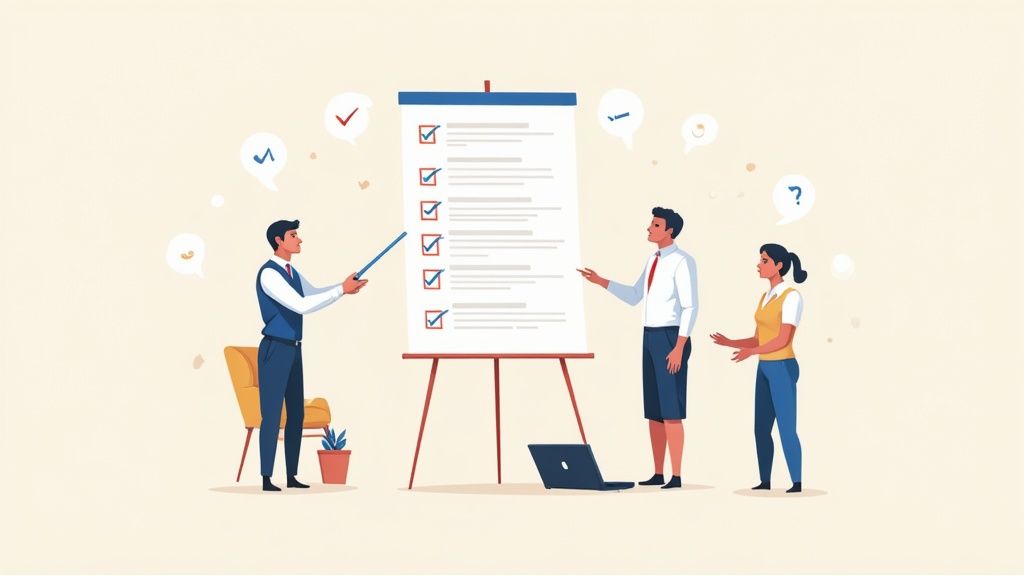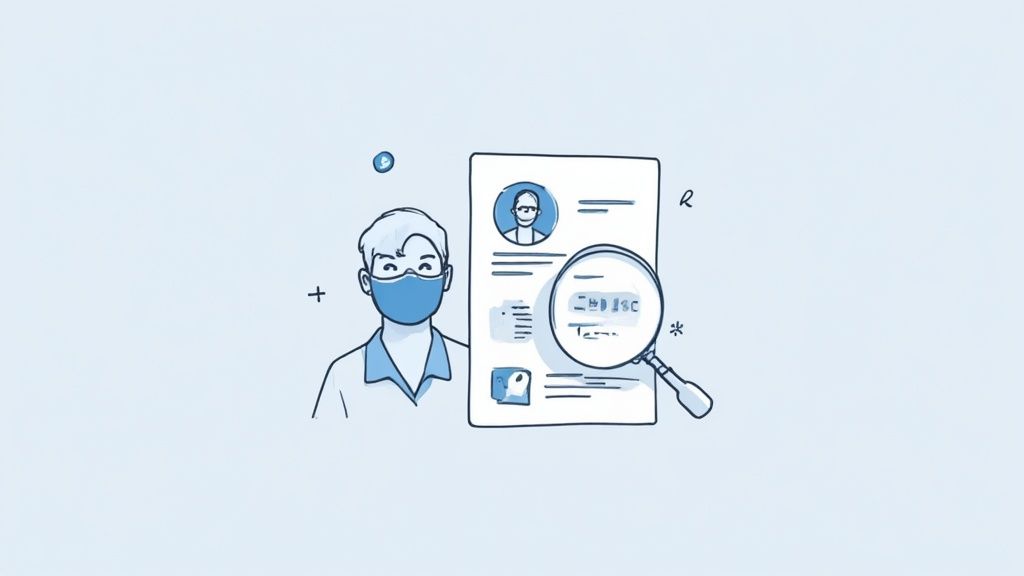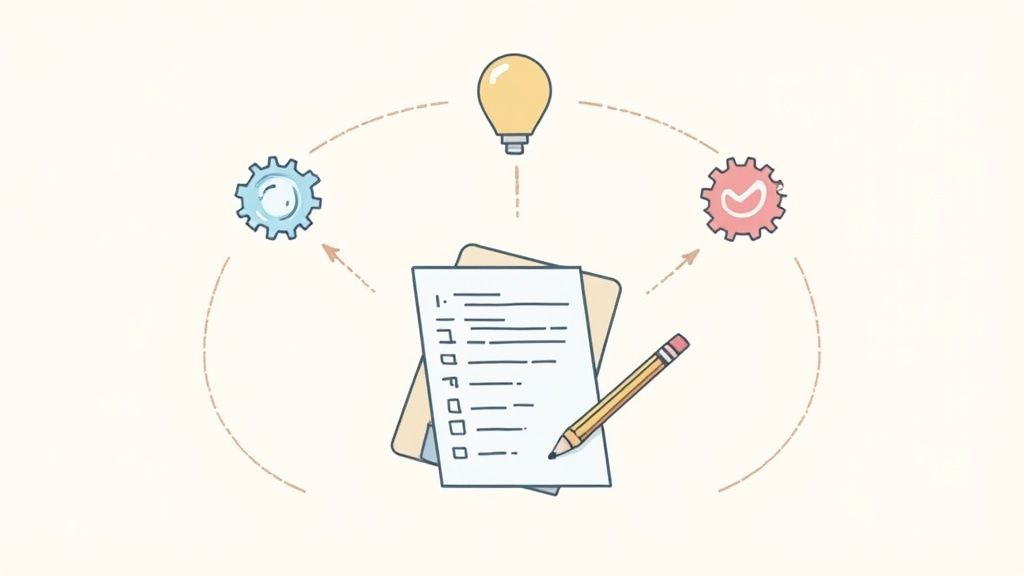
You’ve added the diversity statement to your careers page. You’ve attended the webinars. Hell, you might have even mortgaged the office ping-pong table for a kombucha keg. And yet, your talent pipeline still looks… homogenous. Sound familiar? We've been there. The hard truth is that most well-intentioned diversity initiatives are just corporate window dressing. They feel good, but they don't move the needle.
Real inclusive hiring practices aren't about lofty statements or performative gestures. They're about systematically de-bugging the bias hardwired into every step of your process, from the first job description to the final offer. We’re talking about the subtle—and not-so-subtle—ways we screen out brilliant people for reasons that have zero to do with their ability to excel. This isn't another lecture filled with vague advice. It’s a field guide from the trenches, for founders and hiring managers who want to know what actually works.
We'll break down the specific, actionable strategies that move beyond good intentions. These are the tactics we've used to build high-performing teams, especially when tapping into the incredible, often overlooked, talent pool in Latin America. Let's get real about what it takes to build a team that isn't just diverse on paper, but dominant in practice.
Let’s be honest, traditional interviews are often just a vibe check. You ask some questions, the candidate asks some questions, and you walk away deciding if you’d want to be stuck in an airport with them. Fun, maybe. Effective? Not a chance. This gut-feel approach is a minefield for unconscious bias and one of the worst predictors of on-the-job success. Structured interviewing is the antidote to this hiring malpractice.
It’s a standardized process where every candidate for a specific role gets the same set of predetermined questions, in the same order. Think of it less like a casual chat and more like a scientific instrument designed to measure one thing: job-relevant skills. By creating a level playing field, you base your decision on competence, not rapport. This is a non-negotiable cornerstone of any serious effort toward inclusive hiring practices.

Pioneered by researchers and famously implemented by Google’s People Operations team, this isn’t about making your life harder. It’s about making your decisions smarter. Google discovered that structured interviews were significantly more predictive of performance than unstructured ones. Turns out, data beats "good vibes" every time. When you’re hiring remote talent from diverse backgrounds, like skilled developers from Latin America, this consistency is your best friend. It removes the guesswork and helps you identify top performers who don't fit a familiar mold.
Key Insight: Unstructured interviews are excellent at measuring one thing: how good a candidate is at unstructured interviews. Structured interviews measure how good they’ll be at the actual job.
Ready to stop hiring based on gut feelings? Here’s the playbook.
Your brain is a brilliant but lazy pattern-matching machine. It sees a name like “Javier” and unconsciously pictures a man, or sees a graduation date from 1995 and thinks “not a digital native.” These mental shortcuts, or unconscious biases, slam the door on incredible talent before they even get a chance. Blind resume screening is your way of telling your brain to sit down and be quiet, so you can actually focus on what matters.
This practice involves systematically removing identifying information—names, photos, addresses, graduation dates—from resumes during the initial screen. It forces a pure, unbiased evaluation based on one thing: a candidate’s skills and experience. It’s one of the most powerful and straightforward inclusive hiring practices you can implement to level the playing field.

This isn't some new-age HR trend; it's a proven method with roots in a surprising place: classical music. In the 1970s, symphony orchestras introduced blind auditions where musicians performed behind a screen. The result? The number of female musicians skyrocketed. More recently, the UK's civil service saw a 13% increase in diversity after adopting blind recruitment. The evidence is clear: when you remove identity, you hire for ability.
Key Insight: Blind screening doesn't just change who gets an interview; it fundamentally changes the quality of your candidate pool by forcing you to evaluate talent on merit alone.
Ready to stop judging books by their covers?
If you send a candidate to interview with four clones of the same person, you’re not getting a well-rounded assessment. You’re just getting the same opinion four times. This is the definition of groupthink, and it’s a killer for diversity. Relying on a homogenous group to evaluate talent reinforces existing biases and perpetuates a culture where everyone looks, thinks, and acts the same. Diverse interview panels are the direct countermeasure.
The concept is simple: assemble an interview team with people from different backgrounds, departments, genders, and ethnicities. You actively challenge unconscious bias and gain a far more comprehensive picture of a candidate's abilities. For a candidate from an underrepresented group, seeing this commitment in action is a powerful signal that your company doesn't just talk the talk.

This isn’t about checking a box. It’s a strategic decision proven to lead to better hires. Companies like Salesforce and Intel do this because they know that varied perspectives catch different things. An engineer might focus on technical execution, while a product manager assesses collaborative skills, and a representative from an employee resource group evaluates a candidate's potential contribution to the company culture. It’s one of the most effective inclusive hiring practices for breaking down affinity bias—where we naturally favor people who remind us of ourselves.
Key Insight: A homogenous panel measures a candidate’s fit with the past. A diverse panel measures their potential to contribute to the future.
Ready to stop hiring in an echo chamber?
Let's get real for a second. Your prized Ivy League degree filter is a relic. Relying on credentials like degrees or a specific number of years of experience is like judging a chef by their cookbook collection instead of tasting their food. You’re screening out brilliant, self-taught developers and resourceful designers who took a non-traditional path. Skills-based assessment flips the script by focusing on what truly matters: can the candidate actually do the job?
This approach uses practical tests, work samples, and real-world problem-solving exercises to measure capability directly. It’s about prioritizing proven ability over pedigree. For companies serious about building a diverse, high-performing team, this is one of the most effective inclusive hiring practices you can adopt. It levels the playing field for exceptional talent, regardless of their resume.

This isn't about giving every candidate a generic quiz. It’s a strategic shift. IBM's "New Collar" jobs program famously hires for skills, not just degrees. Companies like Google and Ernst & Young have dropped degree requirements for many roles, recognizing that competence isn't confined to a university campus. When you're hiring top-tier remote talent from Latin America, this focus on tangible skills ensures you're accessing the entire talent pool, not just the fraction with a specific diploma.
Key Insight: Resumes tell you what a candidate claims they can do. Skills assessments show you what they actually can do. One is marketing, the other is proof.
Ready to hire for what people can do, not where they went to school?
Your job description is the front door to your company. If that door has a sign saying "experts only" or is written in language that only appeals to one type of person, you're turning away incredible talent before they even consider knocking. An inclusive job description isn’t about buzzwords; it's a strategic tool designed to attract the widest possible pool of qualified candidates, making it a critical part of your inclusive hiring practices.
It’s about ditching the corporate jargon and laundry list of "nice-to-have" skills. Instead, you focus on the impact someone will make and the core competencies needed to get there. This simple shift can dramatically change who feels confident enough to apply.
This isn't about being overly sensitive; it's about being smart. Atlassian uses Textio to scrub its job postings of biased language, while Buffer famously saw a 42% increase in applications from women after rewriting its descriptions. The language you use is a direct signal of your company's culture.
A crucial step in crafting truly inclusive job descriptions involves thoroughly analyzing existing ones for biases and clarity, which can be further informed by understanding effective job description analysis. When you eliminate unnecessary barriers like arbitrary "years of experience" or gender-coded terms ("rockstar," "ninja"), you stop filtering for confidence and start filtering for competence.
Key Insight: A job description is a marketing document, not a legal contract. Its goal is to attract, not to intimidate. If your requirements list reads like an encyclopedia, you’re actively discouraging diverse, high-potential candidates.
Ready to turn your job descriptions into talent magnets?
If structured interviews are the guardrails, bias interruption training is the driver's ed course for your hiring team. You can’t fix what you can’t see, and unconscious bias is the ultimate blind spot. The problem is, these mental shortcuts are often terrible at making fair and accurate hiring decisions.
Bias interruption training is more than a one-off "don't be biased" seminar. It’s a deliberate program designed to make your team aware of these cognitive glitches and give them practical tools to stop bias in its tracks. From affinity bias (favoring people like us) to the halo effect (letting one great trait overshadow everything else), this training exposes the hidden scripts running in our heads. It’s a critical component for any company serious about inclusive hiring practices.
This isn't about shaming people for having biases. It's about giving them the tools to manage them. Big players like Microsoft and Facebook have poured resources into this because it works. When you're hiring top-tier remote talent from diverse regions like Latin America, you can’t afford to let stereotypes about accents or cultural norms cloud your judgment of a candidate's actual skills.
Key Insight: Simply knowing about bias isn't enough to prevent it. Effective training gives people concrete, in-the-moment "interruptions" to use when bias is most likely to creep into a decision.
Ready to move from awareness to action?
Few things reveal bias faster than a salary negotiation. When compensation is a free-for-all, it’s not the most qualified person who wins; it’s the best negotiator. This Wild West approach is a direct pipeline to pay inequity, systematically underpaying women, minorities, and talent from regions with different negotiation norms. A standardized compensation framework is the circuit breaker for this systemic failure.
This isn't about paying everyone the same. It's about paying everyone equitably. A framework establishes clear salary bands for roles based on objective criteria like skill level, experience, location, and impact. It removes the arbitrary guesswork and ensures that when you're hiring a developer from Colombia or a designer from Brazil, their offer is based on their value, not their ability to haggle.
Companies like Salesforce and Buffer didn't adopt transparent pay structures for the PR. They did it because it’s smart business. Salesforce famously spent millions to close its gender pay gap. Buffer took it a step further by publishing its salary formula publicly. This isn't just radical transparency; it's a core tenet of building trust and is central to any serious conversation about inclusive hiring practices.
Key Insight: If you don't have a compensation framework, you still have one. It's just an unwritten, biased one based on who shouts the loudest, who you like the most, and who reminds you of yourself.
Ready to make your pay structure a tool for equity instead of resentment?
So, there you have it. It might feel like you’re being asked to rebuild your hiring engine from scratch while the old one is still running. You are. But let’s be clear: this isn’t about checking boxes on a corporate responsibility worksheet. This is about winning.
These seven strategies aren't just isolated tactics. They are interlocking gears in a high-performance machine. Think about it:
When you stack these inclusive hiring practices, you’re not just being "good"; you’re being relentlessly strategic. You are systematically dismantling the very friction and bias that cause your competitors to overlook A-plus talent, especially within the deep, often untapped, markets of Latin America.
The ultimate goal here isn't a pat on the back. It’s about building a stronger, more innovative, and more resilient team. The most common mistake is admiring the problem. Companies spend months in meetings talking about diversity, but they fail to change the actual systems that produce their hiring outcomes.
Your next move isn’t to schedule another discussion. It's to pick one of these practices and implement it. Start with blind screening this week. Introduce one structured question into your next interview. The talent is out there, ready to build and drive your company forward. You just have to get out of your own way. Stop talking about the house you want to build and start laying the first brick.
